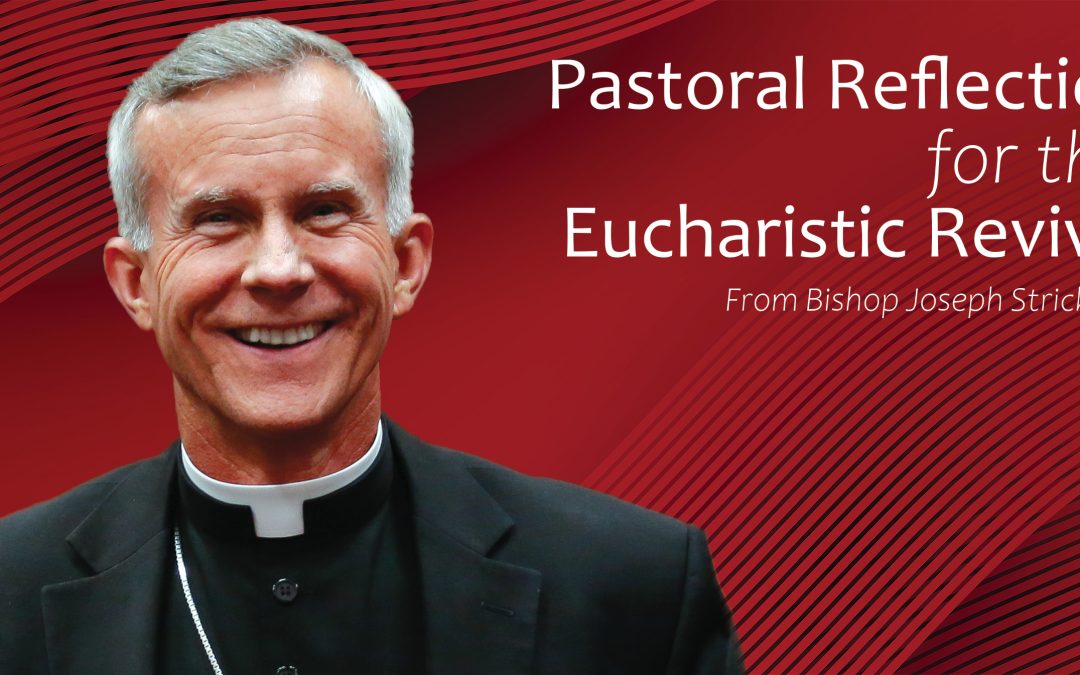As we continue this time of Eucharistic Revival, I have been considering the best ways I can promote reverent reception of the Body and Blood, Soul and Divinity of Jesus Christ. As your shepherd, I know that the worthy and reverent reception of the Eucharist is essential. I want to focus specifically on the question of receiving both species of Our Lord in the Blessed Sacrament. I believe this is tied directly to our need for a fuller understanding of the great mystery of the Eucharist and a deeper reverence for His Real Presence.
I want to reflect with you on the wondrous truth that every time we receive Holy Communion, we are receiving the saving Precious Blood of Jesus Christ. It is my hope that this reflection will help us to encounter the Lord more profoundly each time we receive Him.
Centuries ago, Holy Mother Church clarified for the clergy and faithful that when we receive one species of our Eucharistic Lord, either under the form of consecrated bread or consecrated wine, we are receiving the fullness of the wondrous gift of His sacrificial love in the Blessed Sacrament. This is critical for our ongoing faith journey as we regularly receive Holy Communion, we must remember that we are fully receiving Him and all that He has accomplished for us.
Let us focus first on the reality that we are truly receiving His Body and Blood when we regularly receive the consecrated host with love and reverence either on the tongue or in the hand. We must receive the Lord in profound reverence. Profound reverence toward the Blessed Sacrament is essential because the One who is present in the consecrated host and in the precious blood is truly Jesus Christ. The consecrated host is not an “it” but a “WHO.” Being in His presence, passing before His presence, and praying in His presence, all should be done with the awareness that the person of Jesus Christ is there. Profound reverence is required.
Receiving the Real Presence of Jesus Christ gives the people of God the grace to go out and live His presence in the world, nurtured, strengthened, and empowered with His Body, Blood, Soul, and Divinity. The word eucharist is derived from a Greek word which means thanksgiving. At every Holy Sacrifice of the Mass, we give thanks for the entirety of the life, death and resurrection of Jesus Christ, the kerygmatic event that is Good News for humanity for all time. And we receive the true Body and Blood of Jesus Christ.
In an apostolic letter issued in 2004 entitled “Stay with us Lord” (Mane Nobiscum Domine) St John Paul II wrote:
There is a particular need to cultivate a lively awareness of Christ’s real presence, both in the celebration of Mass and in the worship of the Eucharist outside Mass. Care should be taken to show that awareness through tone of voice, gestures, posture and bearing. In this regard, liturgical law recalls – and I myself have recently reaffirmed – the importance of moments of silence both in the celebration of Mass and in Eucharistic adoration. The way that the ministers and the faithful treat the Eucharist should be marked by profound respect. The presence of Jesus in the tabernacle must be a kind of magnetic pole attracting an ever-greater number of souls enamored of him, ready to wait patiently to hear his voice and, as it were, to sense the beating of his heart. “O taste and see that the Lord is good!” (Ps 34:8). (18)
The mystery of the Eucharist is tied up with the great mystery of the incarnation of God’s eternal Son and the fact that He truly took on flesh in a human body and all that this entails. Christ’s true body is offered to us, thus when we receive a morsel of Him, we receive His Body and the Blood contained within it. Just as no portion of our human bodies is bloodless the same is true for Our Lord and His human body.
We reflect on His entire incarnate journey from His conception, through His gestation, and in the thirty-three years of His saving mission. Let us consider some moments when His Precious Blood is evident. Shortly after His birth, Mary, and Joseph ever faithful to the law of Moses, present Jesus to the Lord and He is circumcised. (Luke 2:21) We can note this is the first time the Precious Blood of Our Lord is spilled, as He undergoes the ritual that every Jewish boy experienced.
Most of the next phase of Jesus’s life is shrouded in mystery with no mention of any detail in the gospels, but we can surmise that there were the scraped knees and elbows of any little boy. As He grew into manhood, we presume He assisted in the carpenter’s trade of His adoptive father, Joseph. And what carpenter hasn’t experienced a few cuts along the way? Thus, we can presume that Jesus’s Precious Blood was spilled in the normal course of His life as a man.
We return to the biblical evidence of the spilling of the Precious Blood of Jesus Christ as we read of His agony in the garden when He sweats blood (Luke 22:44), the scourging at the pillar (Luke 23:22) and as He receives the crown of thorns. (Matthew 27:29) It is my hope that calling to mind these moments of the spilling of the Precious Blood of the Lord will deepen our reverence and awe as we receive His Body and Blood at Mass. The pouring out of His Blood is not an abstract image but a real flesh and blood sacrifice. We receive the full power of His loving gift in the unbloody sacrifice at the Eucharistic altar and it is incumbent on us to seek ever deeper awareness of this wonder.
We continue with Our Lord carrying His cross and shedding blood along the path of His passion. Finally, He arrives at calvary and is crucified with the nails piercing His hands and feet, causing His Precious Blood to be spilled once again. (Mark 15:24) Finally, after He has died, commending His Spirit into the hands of His Father, the soldier’s lance pierces His side causing blood and water to gush forth, thus spilling His Precious Blood one final time after He has died. (John 20:34)
It is essential that we return to these images again and again as we participate in the Mass as bishops, priests, deacons, religious and laity. Reflecting on the true Body and Blood sacrifice of Our Lord enhances our faith, deepens our devotion, and amplifies the meaning of His glorious resurrection. I urge all of us to be more deeply aware that each and every time we receive Him in Holy Communion we are nurtured by the fullness of this mystery and the true sacrifice that the Son of God has offered to save mankind.
It is in this context, as your bishop, I continue to pray and reflect on the question of receiving both the consecrated bread and the consecrated wine at Mass. This has rightly been described as a “fuller experience” of the wonder of the Eucharist, but I believe we must be very careful and intentional when it comes to our practice moving forward. It is my hope that we can adopt a practice in the diocese which highlights and deepens the reality that we always receive the wondrous power of His Body and Blood. I believe it can be a beautiful opportunity at key moments and in special circumstances to delve even more deeply into the wondrous mystery of Our Eucharistic Lord.
Please allow me to conclude with a note of caution for us all. Let us seek to eliminate any tone of casualness that so easily encroaches on our human experience of the mystery of encountering the divine that the Mass is. The Mass is always an opportunity to know God and His wondrous love and mercy more deeply, we gather, always focused on God, Father, Son, and Holy Spirit.
Let us resolve to be especially careful with our language. Language is important and it is our means of speaking of the reality of what we believe. Let us strive to be intentional with our language and instead of referring to “the wine” or “the bread” when speaking of the consecrated species, let us speak of the Body of Christ and of His Precious Blood. Though veiled in the appearance of bread and wine let us always speak after the consecration of the Body and Blood, Soul, and Divinity of Our Lord Jesus Christ. Thus, by our words we will honor Him, give witness to this great gift, and deepen our faith.
En Español
Mientras continuamos este tiempo de Avivamiento Eucarístico, he estado considerando las mejores formas en que puedo promover la recepción reverente del Cuerpo, Sangre, Alma y Divinidad de Jesucristo. Como pastor de ustedes, sé que la recepción digna y reverente de la Eucaristía es esencial. Quiero centrarme específicamente en la cuestión de recibir ambas especies de Nuestro Señor en el Santísimo Sacramento. Creo que esto está directamente relacionado con nuestra necesidad de una comprensión más plena del gran misterio de la Eucaristía y de una reverencia más profunda hacia su Presencia Real.
Quiero reflexionar con ustedes sobre la maravillosa verdad de que cada vez que recibimos la Sagrada Comunión, estamos recibiendo la Preciosa Sangre salvadora de Jesucristo. Espero que esta reflexión nos ayude a encontrarnos más profundamente con el Señor cada vez que lo recibamos.
Hace siglos, la Santa Madre Iglesia aclaró para el clero y a los fieles que cuando recibimos una especie de nuestro Señor Eucarístico, ya sea bajo la forma de pan consagrado o de vino consagrado, estamos recibiendo la plenitud del maravilloso don de su amor sacrificial en el Santísimo Sacramento. Esto es fundamental para nuestro continuo camino de fe, ya que al recibir regularmente la Sagrada Comunión, debemos recordar que le estamos recibiendo plenamente a Él y a todo lo que ha realizado por nosotros.
Centrémonos primero en la realidad de que estamos recibiendo verdaderamente su Cuerpo y su Sangre cuando recibimos regularmente la hostia consagrada con amor y reverencia, ya sea en la lengua o en la mano. Debemos recibir al Señor con profunda reverencia. Es esencial una profunda reverencia hacia el Santísimo Sacramento, porque Aquel que está presente en la hostia consagrada y en la sangre preciosa es verdaderamente Jesucristo. La hostia consagrada no es un “eso”, sino un “QUIÉN”. Estar en su presencia, pasar ante su presencia, y orar en su presencia, todo debe hacerse con la conciencia de que la persona de Jesucristo está allí. Se requiere una profunda reverencia.
Recibir la Presencia Real de Jesucristo da al pueblo de Dios la gracia de salir y vivir su presencia en el mundo, nutrido, fortalecido y fortalecido con su Cuerpo, Sangre, Alma y Divinidad. La palabra Eucaristía deriva de una palabra griega que significa acción de gracias. En cada Santo Sacrificio de la Misa, damos gracias por la totalidad de la vida, muerte y resurrección de Jesucristo, acontecimiento kerigmático que es Buena Noticia para la humanidad de todos los tiempos. Y recibimos el verdadero Cuerpo y Sangre de Jesucristo.
En una carta apostólica publicada en 2004 y titulada “Quédate con nosotros Señor” (Mane Nobiscum Domine), San Juan Pablo II escribió:
Hace falta, en concreto, fomentar, tanto en la celebración de la Misa como en el culto eucarístico fuera de ella, la conciencia viva de la presencia real de Cristo, tratando de testimoniarla con el tono de la voz, con los gestos, los movimientos y todo el modo de comportarse. A este respecto, las normas recuerdan —y yo mismo lo he recordado recientemente— el relieve que se debe dar a los momentos de silencio, tanto en la celebración como en la adoración eucarística. En una palabra, es necesario que la manera de tratar la Eucaristía por parte de los ministros y de los fieles exprese el máximo respeto. La presencia de Jesús en el tabernáculo ha de ser como un polo de atracción para un número cada vez mayor de almas enamoradas de Él, capaces de estar largo tiempo como escuchando su voz y sintiendo los latidos de su corazón. “¡Gustad y ved qué bueno es el Señor¡” (Sal 33 [34],9). (18)
El misterio de la Eucaristía está ligado al gran misterio de la encarnación del Hijo eterno de Dios y al hecho de que verdaderamente se encarnó en un cuerpo humano y todo lo que ello conlleva. Se nos ofrece el verdadero cuerpo de Cristo, por lo que cuando recibimos un bocado de Él, recibimos su Cuerpo y la Sangre que contiene. Así como ninguna parte de nuestro cuerpo humano está exenta de sangre, lo mismo ocurre con Nuestro Señor y su cuerpo humano.
Reflexionamos sobre todo su camino encarnado, desde su concepción, pasando por su gestación, y en los treinta y tres años de su misión salvadora. Consideremos algunos momentos en los que su Preciosa Sangre es evidente. Poco después de su nacimiento, María y José, siempre fieles a la ley de Moisés, presentan a Jesús al Señor y es circuncidado (Lucas 2, 21). Podemos observar que ésta es la primera vez que se derrama la Preciosa Sangre de Nuestro Señor, al someterse al ritual que todo niño judío experimentaba.
La mayor parte de la siguiente fase de la vida de Jesús está envuelta en el misterio, sin que los evangelios mencionen ningún detalle, pero podemos suponer que tenía las rodillas y los codos raspados de cualquier niño pequeño. Al llegar a la edad adulta, suponemos que ayudó en el oficio de carpintero de su padre adoptivo, José. ¿Y qué carpintero no ha sufrido algún que otro corte por el camino? Así, podemos suponer que la Preciosa Sangre de Jesús fue derramada en el curso normal de su vida como hombre.
Volvemos a la evidencia bíblica del derramamiento de la Preciosa Sangre de Jesucristo cuando leemos sobre su agonía en el huerto cuando suda sangre (Lucas 22, 44), la flagelación en la columna (Lucas 23, 22) y cuando recibe la corona de espinas (Mateo 27, 29). Espero que recordar estos momentos del derramamiento de la Preciosa Sangre del Señor profundice nuestra reverencia y admiración al recibir su Cuerpo y su Sangre en la Misa. El derramamiento de su Sangre no es una imagen abstracta, sino un sacrificio real de carne y hueso. Recibimos todo el poder de su don amoroso en el sacrificio incruento del altar eucarístico y nos incumbe buscar una conciencia cada vez más profunda de esta maravilla.
Continuamos con Nuestro Señor llevando su cruz y derramando sangre a lo largo del camino de su pasión. Finalmente, llega al calvario y es crucificado con los clavos que atraviesan sus manos y pies, haciendo que su Preciosa Sangre se derrame una vez más (Marcos 15, 24). Finalmente, después de haber muerto, encomendando su Espíritu a las manos de su Padre, la lanza del soldado atraviesa su costado haciendo brotar sangre y agua, derramando así su Preciosa Sangre una última vez después de haber muerto (Juan 20, 34).
Es esencial que volvamos a estas imágenes una y otra vez mientras participamos en la Misa como obispos, sacerdotes, diáconos, religiosos y laicos. Reflexionar sobre el verdadero sacrificio del Cuerpo y la Sangre de Nuestro Señor aumenta nuestra fe, profundiza nuestra devoción y amplifica el significado de su gloriosa resurrección. Los exhorto a todos a que sean más profundamente conscientes de que cada vez que le recibimos en la Sagrada Comunión nos nutrimos de la plenitud de este misterio y del verdadero sacrificio que el Hijo de Dios ha ofrecido para salvar a la humanidad.
En este contexto, como obispo de ustedes, sigo rezando y reflexionando sobre la cuestión de recibir tanto el pan como el vino consagrados en la Misa. Esto se ha descrito, con razón, como una “experiencia más plena” de la maravilla de la Eucaristía, pero creo que debemos ser muy cuidadosos e intencionados a la hora de avanzar en nuestra práctica. Espero que podamos adoptar en la diócesis una práctica que resalte y profundice la realidad de que siempre recibimos el poder maravilloso de su Cuerpo y de Su Sangre. Creo que puede ser una hermosa oportunidad en momentos clave y en circunstancias especiales para profundizar aún más en el maravilloso misterio de Nuestro Señor Eucarístico.
Permítanme concluir con una nota de precaución para todos nosotros. Tratemos de eliminar cualquier tono de desenfado que tan fácilmente invade nuestra experiencia humana del misterio de encuentro con lo divino que es la Misa. La Misa es siempre una oportunidad para conocer más profundamente a Dios y su maravilloso amor y misericordia, nos reunimos, siempre centrados en Dios, Padre, Hijo y Espíritu Santo.
Decidámonos a ser especialmente cuidadosos con nuestro lenguaje. El lenguaje es importante y es nuestro medio para hablar de la realidad de lo que creemos. Esforcémonos por ser intencionados con nuestro lenguaje y, en lugar de referirnos al “vino” o al “pan” al hablar de las especies consagradas, hablemos del Cuerpo de Cristo y de su Preciosa Sangre. Aunque velados en la apariencia del pan y del vino, hablemos siempre, después de la consagración, del Cuerpo y de la Sangre, del Alma y de la Divinidad de Nuestro Señor Jesucristo. Así, con nuestras palabras le honraremos, daremos testimonio de este gran don y profundizaremos en nuestra fe.



